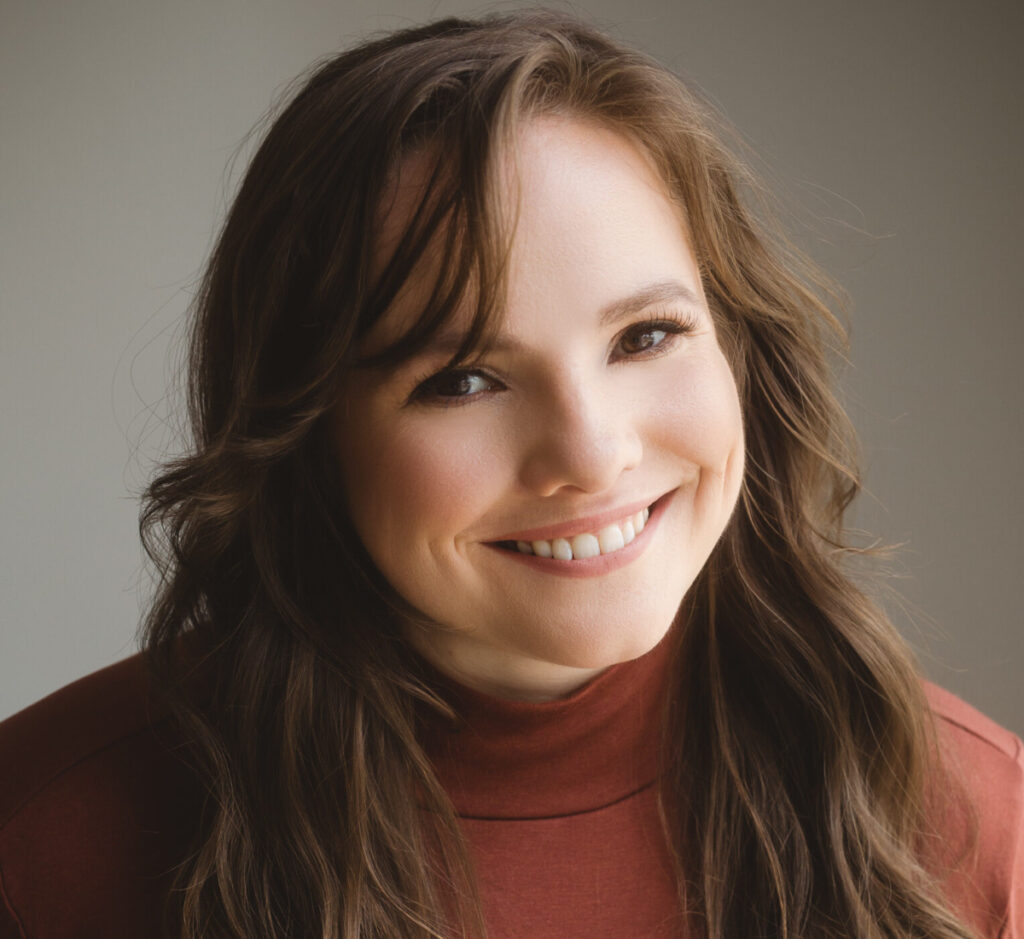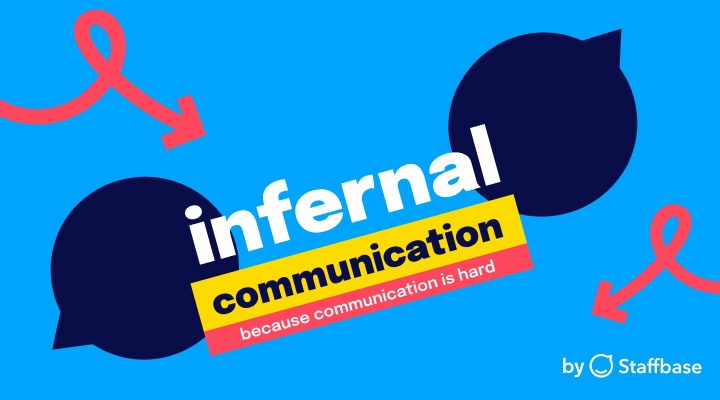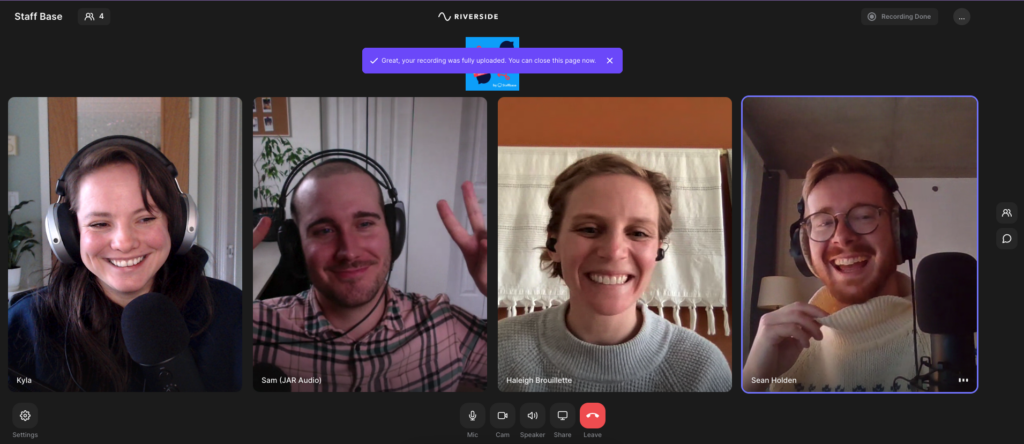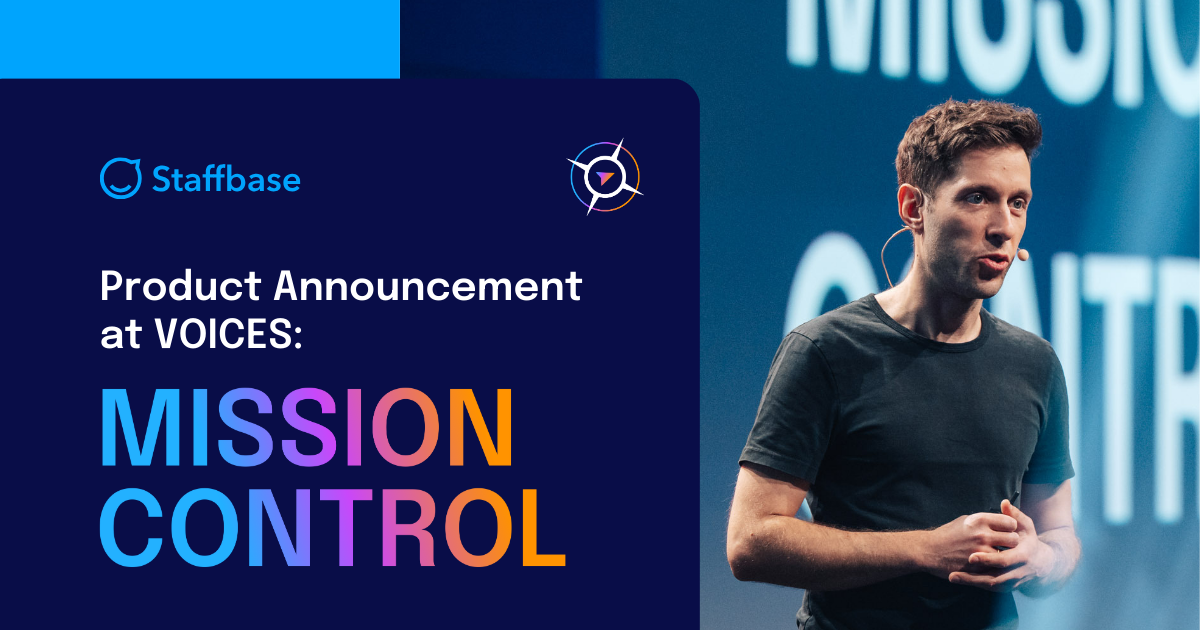Think of the last time you traveled. Or did chores. Or even went for a walk.
If you're like me, you may have passed the time with a podcast.
There's nothing better than getting swept up in a compelling story. From the initial hook to compelling interviews . . . to the feeling that you can't wait to tell your friend to download it, too.
Podcasts transport us to different worlds and expose us to new perspectives. And they do it all with a simple press of a button (which is pretty much magic, right?).
That's why I was ecstatic to hear that Kyla Sims, Principal Audience Engagement Manager at Staffbase (and fellow audiophile) created the Infernal Communication podcast.

Infernal Communication is the latest podcast in the internal communications space. But it's not just any podcast.
In each episode, Kyla digs deep into the ups and downs of internal comms — like the age-old request to "make it pretty" or how the "flatten the curve" messaging during the pandemic was one of the most effective comms campaigns ever.
Internal comms attracts some of the kindest, most resilient, intelligent, and compassionate human beings I’ve ever met — and they deserve to be appreciated and seen."
Kyla Sims
Through expert interviews and razor-sharp narration, Infernal Communication really challenges the listener's assumptions of the comms profession. Trust me . . . even after just one listen, you'll think of your job in a whole new light.
I asked Kyla for her behind-the-scenes insights into making a podcast, how Infernal Communication stands out from the crowd, and what she's learning along the way. Here's our conversation:
How did the idea for Infernal Communication come about?
Kyla: As a huge podcast nerd, I had quite a few ideas about how we could approach the podcast from a unique angle or novel format. Narrowing them down was the challenge.
So I organized a small focus group through Comms-unity, and interviewed internal comms pros about which podcasts about internal comms they listened to. To my surprise, most of them had never listened to any of the many wonderful podcasts in our industry. It was baffling. And when I asked them why, it always came down to the same thing: It feels like work.
People consume podcasts when they’re commuting, running errands, cleaning the house, going for a walk, etc. This is their downtime when they don’t want to think about work. So bringing "work talk" into this personal time without making it feel like work was going to be really tricky.
With feedback from the focus groups and a few consultants in the industry (shout out to Jason Anthione and Pinaki Kathiari!), we decided we wanted to take a more narrative approach than the traditional interview format, and that we’d really have to push the storytelling angle to make it not feel like work.
So when I was trying to explain to various production companies that I was vetting what I was looking for and the vibe I was trying to cultivate, I kept coming back to a card game that we had made back in the day, based on Cards Against Humanity, called Infernal Communication.
Looking through those cards became our jumping-off point. We decided each episode we’d explore a common gripe or comms-related issue (often drawing inspiration from the game cards) and invite fresh voices to offer new perspectives and connect the ideas to what was going on in our wider world with storytelling.
And that’s how Infernal Communication was born.

Walk us through the making of an episode. How did you go from an initial idea to a fully produced episode?
Kyla: Because we contracted an agency to help us with the production and promotion, we did most of the ideation for the entire season months ago. Taking a storytelling approach meant needing to know where we were going in the season and making sure it was all connected and coherent.
So, in the very beginning (with support from JAR Audio) we went through our Infernal Communication game cards and started brainstorming. From there, we went back and forth until we settled on twelve solid ideas we could build on.
Because we were bringing in experts, and you never know what they’re going to say, we needed to have a good idea of what we wanted to talk about, but remain pretty flexible about wherever the interviews would take us and what stories would emerge.
So for each episode, we take our basic premise and whip together a script based on pre-interviews we have with possible guests. Next, we record. Each episode has at least two guests, so we have separate recording sessions for each of those interviews, and then another recording session to do voiceover work and narration.
Once we record all the audio, our production team at JAR Audio works their magic. They cut the interview and voiceovers together, add a little magic (i.e. sound effects and production value) and then send us a fine cut draft of the episode.
I am a perfectionist, a podcast nerd, and an all-around pain in the butt, so of course, I give pages and pages of feedback for each episode. The JAR Audio team graciously accepts my rambling and then goes back and makes changes. From there, maybe we rewrite or re-record some sections, and then finally we get our final episode. Ta-da!
There are tons of podcasts in the internal comms space. What makes the Infernal Communication podcast different and why should someone listen to it?
Kyla: When I convinced Staffbase to let me create a podcast, I knew it had to be different than what was already on offer.
More than 90% of IC podcasts follow a similar format: interviews or panels with internal communication experts to discuss various topics. Don’t get me wrong, this is a great approach! But it didn’t make sense to me to add to the noise and do more of the same. It was being done — and done better than I could have ever done it.
During the ideation stage, I was guided by three principles that I knew would set us apart:
First, it couldn’t feel like work. No matter what — it needed to be something people could listen to in their off time and it wouldn’t stress them out. I like to call this the “more cake, less vegetables” approach.
Second, it needed to have fresh voices. We’re very lucky in our space to have so many incredible practitioners and consultants who offer their insights and resources — but if we were going to make the podcast feel less like work, we were going to have to reach beyond IC.
And finally, it needed to have broad appeal. My guiding vision was an IC pro listening to an episode and then turning to their partner, friend, or colleague and saying, "Did you know...?" because the truths and insights would be so universal that anyone could relate.
For the most part, I think we satisfied these criteria pretty well. The podcast really does have something for everyone and is completely unique in our industry. You’re more likely to hear a podcast like ours on Radiolab, Wondery, or NPR than in the internal comms space, and though I love our space and the incredible experts who work in it, I am also really proud that it’s completely different. We really have fun with it and I think people will pick up on that.
What does a podcast have that other content formats don't?
Kyla: Podcasts are one of the most wonderful content formats I’ve ever had the pleasure to work with.
They’re interesting because they are one of the only marketing channels that the audience takes home with them. They go where you go. They’re super accessible through apps you already have on your phone, that you access in your downtime, and that you already likely have some positive association with.
They also allow you to bring in experts from literally anywhere. As long as you can get a mic, you’re good to go. This creates a lower barrier of entry for potential guests, which makes it easier for them to say yes to being on the show.
And of course, you can have so much fun with them. Because you’re in someone’s ear — they are doing the hard work of imagining what you’re saying. To help, there are lots of interesting audio elements you can play with to build tension, delight, dazzle, make people laugh, etc. From audio plays and sound effects to background music, there’s so much potential because you’re just piggybacking on the listener’s brain. It’s so fun to play with that.

Haleigh Brouillette, Sr. Manager of Corporate Communications at Hudl; and
Sean Holden, Producer at JAR Audio
As a content creator, what have you learned from this whole experience?
Kyla: One thing that I’ve learned from this process (and am still learning) is to let go.
I am a control freak. When I’ve created other content like webinars, reports, or blog posts, I have been really protective and controlling — because I want them to be absolutely perfect. And because of how those things are made, I have, for the most part, been able to maintain that level of control.
But this process has been a real test of my ability to let go.
It’s so much more complex than writing a blog or hosting a webinar. There’s so much more at play and a lot of stuff that you can’t really control. But it’s also reinforced for me that if you’re working on something you’re really passionate about, with a curious mindset, love in your heart, and with love and respect for your audience — no matter what, it’s going to resonate with someone.
Another thing that really surprised me with this process (which it really shouldn’t have when I think about it) is how incredibly generous, kind, thoughtful, and willing to help our community is.
Obviously, I’ve been in the IC community for a few years now, and know that they’re the best but bringing them into this process with me was the single smartest thing I could have done. They set me on the right path, told me the hard truths, and gave me so much insight and encouragement that it felt like I couldn’t fail.
What do you hope internal communicators will take away from the series?
Kyla: I’ve thought about this a lot.
There are the obvious, sort of, "tangible takeaways" comms pros will get from the episodes that they can bring into their work and life throughout the series. There are lots of little nuggets in there and everyone will probably take away something different. And that’s great.
But for me, I’d be perfectly happy if the only thing they took away from the Infernal Communication podcast is the feeling that someone out there really cares. Because I really do. I care about them, what they do, who they are, how they show up, the challenges they face, their triumphs, and their regrets.
I want them to feel good, and to feel seen. And I want them to know that there are people out there who have the utmost respect for what they do and are willing to advocate for them, invest, put their money where their mouth is, and work tirelessly to lift them up and make them feel good — because they are so, so worthy of that.
We didn’t just make this podcast for "internal communication professionals" — we made it for the human beings who wear those titles and play those roles. Internal comms attracts some of the kindest, most resilient, intelligent, and compassionate human beings I’ve ever met — and they deserve to be appreciated and seen.
So, yeah, it’s a little cheesy, but ultimately that’s what I hope they take away from the podcast.
Ready for more Infernal Communication?
Listen to the very first episode below!
Kyla looks at how communicators can deal with the request to "make it pretty" (we've all been there... myself included 😅).
And make sure to subscribe to the Infernal Communication podcast — it's available wherever you like to listen to your podcasts.




